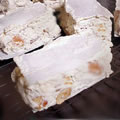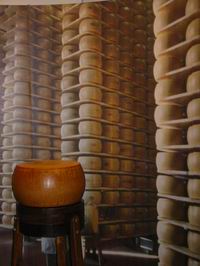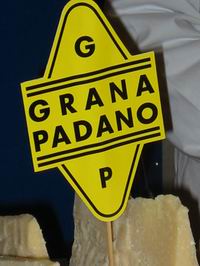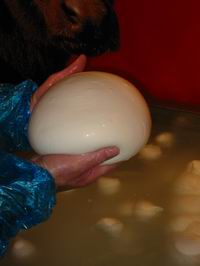|
It's impossible to list all italian products and traditional recipes, but we want tell you some curiosity about famous foodstuffs.
 Coffee Coffee
or better, "the espresso", has peculiarities that make it sole: first of all is "little" about half of a cup if is normal, also less if it's "short", a full cup if it's "long"; presents the characteristic foam, whose colour, from the beige at the brown, dipends from the worn blend. Can be drunk 'black' or 'dashed', that is with the addition of little hot or cold milk and bitter or sugared at please. If you have a machine for the espresso will not be difficult have an excellent coffee also at home: the right quantity of a good blend, with the suitable grinding and adequately pressed in the filter, a cup, better if cold, and the game is made. In Italy, in the house, is very used also the 'coffee-pot' or 'moka' that allows to obtain simultaneously more cups (1-2-3-6-8-12-24), the coffee has not foam, has a more delicate flavor, but contains more caffeine of the espresso as the water remains for more time at contact with the blend. Some nutritional information: an espresso coffee cup contains from 60 at 100 mg of caffeine and only 2 calories; the nutritionists advise do not to surpass 4 cup at the day, really do not ingest too caffeine that, in contents doses, is instead beneficent.
 The Torrone The Torrone
typical sweet of Cremona, is one of the symbol of the city, the torrone boast a precise date of birth, as much for the torrone so it is arrive at our days. The sweet has to the own name, incontrovertibly, at the "Torrazzo", the hightest bell-tower in masonry of Europe, is orn the day of the marriage between Bianca Maria Visconti and Francesco Sforza; the cook of court kneaded almonds, honey, hazels, rinds of lemons, albumens whips at snow and candied fruits, encloses the mixture in a thin wafer and gave it the shape of the Bell-Tower symbol of the city.
The Parmigiano Reggiano 
cheese from table or from grater, the Parmigiano is produced, like proposes the name, in Emilia Romagna, but also in a narrow zone of the Lombardy in the neighbourhood of Mantova. The milk comes from chosen breedings, where the cows are fed only with green forage, dry fodders and hay of meadow, it is then subordinated at handicraft working, during that is absolutely banished the use of additives or preserving and has a priod of seasoning of about 15-18 months in the 'scalere' features. The product is excellent, either for the organolettiche property or nutritional: high nutritious values, lower content of cholesterol, no track of lactose, very good digestibility and an aroma that makes it perfect on the table at accompany first dishes, cold cuts, products from oven, fruits, honey and vegetables. The Parmigiano Reggiano is a product at Denomination of Protect Origin (D.O.P.); only the cheese produced with the rules gathered in the Discipline of production can be adorned of the mark Parmigiano Reggiano and so should restore on the shape the trade-mark for the identification and the distinction of the product.
 The Grana Padano The Grana Padano
The birth of the Grana Padano traces at the dawning of the second millenium, epoch in which the Cistercensi monks reclaimed a wide area of the Po plain. The creation of huge pieces of ground reserved at the pasture increased the production of milk that risked to stay in great unused extent. The monks were worried therefore to improve the 'recipe' of the Grana Padano that consents the utilization of large quantitative of milk do not unchanged the nutritious property and assuring a long preservation. These features favoured it in short time the diffusion on the tables of the nobles and of the people and the business in the adjacent zones. The working of the milk for its change in Grana, growed in short time one of the bearing columns of the agricultural economy and the process was handed on unaltered in the centuries until at us. To protect the 'good name' of the Grana and its features, in 1954 was founded the Association for the protection of the Grana Padano and subsequently, after one year, a Decree sanctioned it the Denomination of Controlled Origin. Now the Grana is also a D.O.P. cheese, that is a Denomination of Protected Origin. But whis is a sole cheese? The cows whose milk is destined at the production of the Grana are selected, controlled and fed alone forages and mixture of cereals and leguminosae. The working follows the traditional phases and the seasoning is followed and checked for at least 12 months. The Grana is defined a semi-fat cheese, in that the milk comes partially skimmed in the first phase of change. During the seasoning besides the enzymes works a kind of "digestion" that makes the Grana an fit nourishment at the children and elderly, as well as at the women in pregnancy and during the suckling, for the high nutritious and the excellent digestibility. To be worth mention some of the nutritional features of this food: for obtain 1 kilo of Grana are necessary 15 liters of milk, that means in 30 grams of cheese is concentrated the nutriment brought from half litre of milk. With 50 grams at the day of grana an adult is ensured the 50% of the daily requirements of calcium, with a contribution of alone 70 milligrams of cholesterol, let alone proteins same at those of a steak of bovine of almost 100 grams. So is clear the reason for that the Grana Padano is considered a speciality of whom our country can be proud.
 Il Raw ham of Parma: Il Raw ham of Parma:
the word 'ham', derives from the latin and literally means 'dried': in fact is the long and cared seasoning that gives at the ham the own sole features. The zone of production of the Parma's Ham is what can guarantee the perfect climatic conditions for the seasoning so to be able receiver the international recognition of D.O.P. (Denomination of Protected Origin). In order to defend the quality of the product, was born, almost fourty years ago, the Association of the Parma's Ham, so take care of the features and the methods of making. The porks, whose legs will give the ham, are bred and fed with principles more rigids in 11 regions of the center-north Italy: the ham of Parma is for definition bereft of dues and preserving, can be defined "sweet" because the quantity of salt used for the salting of the legs is that indispensable minimum and is not increased to accelerate the times of the seasoning. In fact is the time, with the able hands of the prosciuttai teachers, to guarantee the goodness of the ham: after 12 months of seasoning in environment with the perfect micro-climate, the leg is subjected at the test of the "spillatura" and only the hams that pass this test will be marked with the Ducal Crown at 5 points, symbol of the Association. Notable are the nutritional features of the Parma's Ham: deprived of the visible stout, at parity of weight, brings a quantity of lipidi inferior at the meat of bovine and at the breast of turkey; being a totally natural product is suitable at the nutrition of the tiniest, also because thanks at the seasoning its proteins are more digistible. How to relish at the better its flavor? It can be joined at the toast and with butter, at the melon, at the figs or also at the exotic fuits; it is used in the preparation of numerous dishes, traditional and not. It is accompanied perfectly with white or red wines and, also if a seasoned Lambrusco, a dry Malvasia or a sweet Fortana of the parmensi and piacentini hills are its ideal partners, it is joined with success at quite a lot regional wines and, because no, also at a globet of Champagne.
 The Pesto, The Pesto,
Typical ligurian product is a sauce commonly used to serve pasta (short or long) or to flavour other dishes. Thepesto has ancient origins: the basil, aromatic tree and principal ingredient of the preparation, was imported from Africa and from tropical Asia and found the ideal habitat for its increase in this region from the mild climate and with the suitable ground. The original recipe of the pesto foresees for its preparation a mortar in white marble of Carrara in which are crushed, with a pestle of box-wood, the leafs of basil with garlic, pinoli and salt; at follow add sheep's milk cheese and parmesan grated and finally extravergin olive-oil and is worked until to obtain a homogeneous cream.
The Sauce of Nuts,
is very good to accompany fresh pasta and the traditional pansotti is a version "at the nuts" of the genoese pesto. The ingredients in fact are not move away from the two preparation, made exception, obviously, for the replacement of the basil with kernels of nuts.
It is not of difficult preparation also home-made; those are the necessary ingredients:
- gr. 100 of skined kernels of nuts
- gr. 10 pine-seeds
- gr. 80 butters
- grated parmigiano
- gr. 30 leafs of basil
- 2 cloves of garlic
- extra virgin olive-oil, salt and white pepper q.b.
For the preparation: toast in oven the kernels of nuts and the pine-sseds. Put them still hot in a mortar and pound to reduce them in dust. Fry slightly the butte in a pan, add the nuts and the pine-seeds and mix, making cook for 5 minuts. Take from the fire and add the cheese, the salt, the white fresh pounded pepper and the basil and the garlicminced thin. Pass all at the mixer, add two spoon of boiling water and operate the instrument for some minut. In the same time make fall a trickle of fine oil till the sauge is not fluid and flowing.
 The Onion of Tropea The Onion of Tropea
is characterized from the red color of the shell-like and from the shape slightly extended. It arrived in Italy imported over two thousand years ago from the Phoenincian and ever since is cultivated in Calabria growing in the centuries one of the typical products of the tirrenica coast of the region. The special micro-climate of the zone, characterized by a mild winter and a hot summer without strong thermal jerks, the brackish and the ground are the cause of the unusual sweetness at the palate of the “Red of Tropea” that has pulp full of saccharose, fructose and glucose. Its particular and delicate flavor give back it perfect for the use to raw like ingredient in the salads, being a lot of digestible; the caloric contribution is limited, only 20 calories for each 100 grams of fresh product. It's in loose sale, at weight or collected in braids and hung up (this way of preservation assures the quality of them for some months).
The Pizza
 won over the world with his original semplicity: dough, tomato-sauce, olive-oil, basil or marjoram. The Pizza Margherita was invented during 1889 by a Neapolitan cook Raffaele Esposito: he maked it for Queen Margherita, King Umberto's wife to draw inspiration from three colors of Italy's flag; the Quenn appreciated, more than the patriotic sense, the taste of new recipe and so pizza had Queen's name. From then on italians cooks created a lot of kind of pizza adding to classic ingredients also fishes, vegetables, cheeses, eggs, pickles, mushrooms in oil and even fruits or fries potatoes with mayonnaise! won over the world with his original semplicity: dough, tomato-sauce, olive-oil, basil or marjoram. The Pizza Margherita was invented during 1889 by a Neapolitan cook Raffaele Esposito: he maked it for Queen Margherita, King Umberto's wife to draw inspiration from three colors of Italy's flag; the Quenn appreciated, more than the patriotic sense, the taste of new recipe and so pizza had Queen's name. From then on italians cooks created a lot of kind of pizza adding to classic ingredients also fishes, vegetables, cheeses, eggs, pickles, mushrooms in oil and even fruits or fries potatoes with mayonnaise!
 The Pasta The Pasta
water, meal and salt: that is enough to create one of the most versatile dish of italian cusine; like the pizza, the pasta was exportated all over the world too and cooks' fantasy invented a lot of variations: short, long, with eggs, stuffed, lasagne, served with simple sauce (spaghetti withh tomato and basil or with slightly-fried oil, garlic and chilli)or more elaborated (Spaghetti alla Carbonara, Pizzoccheri Valtellinesi).
The Gorgonzola cheese
has very old origins, although, like many other traditional food products, it has no official birth certificate but many hypothetical and legendary ones.
Some claim that gorgonzola was first made in the town of the same name situated just outside Milan, in the year of grace 879. Others, instead, believe that it was born in the important dairy centre of Pasturo, in the Valsassina, where the natural caves, with an average temperature ranging from 6 to 12 °C, represented the perfect conditions for the maturing of gorgonzola as well as several other cheeses.
Gorgonzola's producers became preoccupied with the need to protect their product. In the 50s Italian law No. 125/1954 was issued to regulate original and typical products, and the deriving decree law assigned to gorgonzola, like parmesan, Roman pecorino and other Italian and foreign cheeses, the right to the controlled designation of origin.
In 1970, the Consorzio di Tutela (Protection Consortium) was founded.
By law and tradition, only two Italian regions produce Gorgonzola, and in these regions only the provinces of Novara, Vercelli, Cuneo, Biella, Verbania and the territory of Casale Monferrato, in Piedmont, and the provinces of Bergamo, Brescia, Como, Cremona, Lecco, Lodi, Milan, Pavia and Varese, in Lombardy.
Only the milk from the herds bred in these provinces may be used in the production of gorgonzola and gives right to the protected designation of origin (P.D.O.), thus guaranteeing the quality of this important cheese from the raw material. We could rightly say that thanks to the healthy fodder and the high hygienic standards employed in the farms of the consortium's territory, the milk used in the production of "gorgonzola" is the primary requirement to obtain a high-profile product. We thank Consorzio Tutela Gorgonzola for texts and image
Do you want to try to put yourself in kitchen with our recipes? click here! |


 Munch: The Scream Within
Munch: The Scream Within In the garden
In the garden Perugia Travel Guide
Perugia Travel Guide


 Coffee
Coffee The Torrone
The Torrone
 The Grana Padano
The Grana Padano Il Raw ham of Parma:
Il Raw ham of Parma: The Pesto,
The Pesto, The Onion of Tropea
The Onion of Tropea won over the world with his original semplicity: dough, tomato-sauce, olive-oil, basil or marjoram. The Pizza Margherita was invented during 1889 by a Neapolitan cook Raffaele Esposito: he maked it for Queen Margherita, King Umberto's wife to draw inspiration from three colors of Italy's flag; the Quenn appreciated, more than the patriotic sense, the taste of new recipe and so pizza had Queen's name. From then on italians cooks created a lot of kind of pizza adding to classic ingredients also fishes, vegetables, cheeses, eggs, pickles, mushrooms in oil and even fruits or fries potatoes with mayonnaise!
won over the world with his original semplicity: dough, tomato-sauce, olive-oil, basil or marjoram. The Pizza Margherita was invented during 1889 by a Neapolitan cook Raffaele Esposito: he maked it for Queen Margherita, King Umberto's wife to draw inspiration from three colors of Italy's flag; the Quenn appreciated, more than the patriotic sense, the taste of new recipe and so pizza had Queen's name. From then on italians cooks created a lot of kind of pizza adding to classic ingredients also fishes, vegetables, cheeses, eggs, pickles, mushrooms in oil and even fruits or fries potatoes with mayonnaise! The Pasta
The Pasta